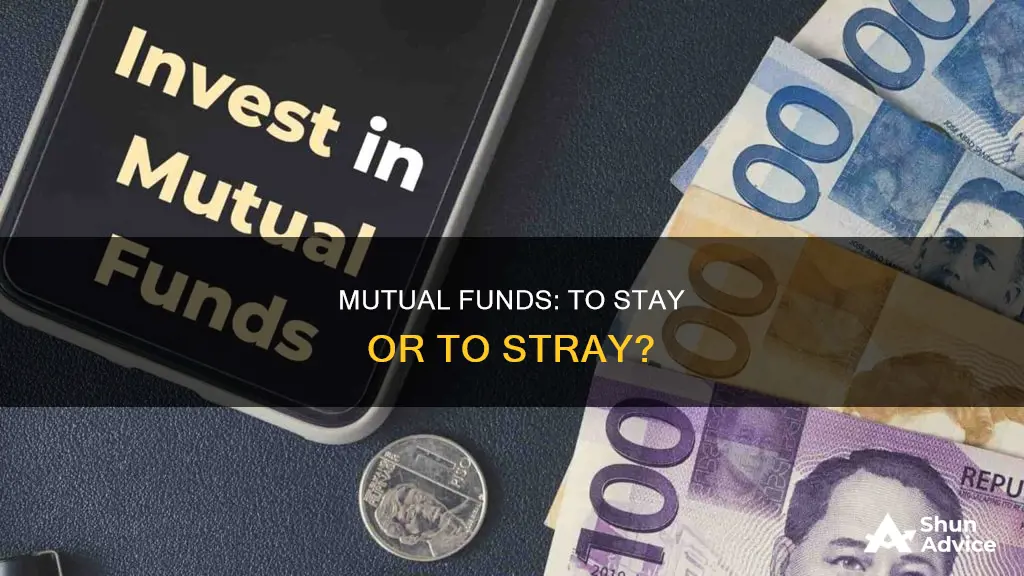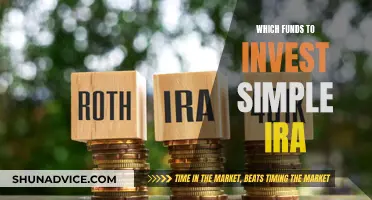
Investing in mutual funds is a popular choice, especially for retirement accounts, as they are a relatively hands-off way to invest in a variety of assets. However, there are several factors to consider when deciding whether to continue investing in mutual funds, including risk tolerance, investment goals, time horizon, and fees.
Mutual funds are considered safer than picking individual stocks due to diversification, but they may not offer the same high returns as some stocks. It's important to evaluate your financial goals and risk tolerance before deciding whether to continue investing in mutual funds. Additionally, understanding the fees associated with mutual funds is crucial, as they can impact your overall returns.
There are alternatives to mutual funds, such as exchange-traded funds (ETFs), which offer lower fees and greater flexibility. Ultimately, the decision to continue investing in mutual funds depends on your personal financial situation, risk appetite, and investment objectives.
| Characteristics | Values |
|---|---|
| Risk | Less risky than individual stocks due to diversification |
| Returns | Historically high average annual returns |
| Timeframe | Long-term investment |
| Fees | Vary from fund to fund; some charge fees when you buy or sell, others are free |
| Management | Actively or passively managed |
| Taxation | Tax liabilities may be incurred |
| Accessibility | Minimum investment often required |
What You'll Learn

Risk tolerance
- Understanding Risk Tolerance: Risk tolerance is highly subjective and varies from person to person. It involves assessing your emotional and financial capacity to handle investment risk. Ask yourself how comfortable you are with potential fluctuations in the value of your portfolio. Can you tolerate dramatic swings, or do you prefer a more conservative approach? Defining your risk tolerance will help you make informed investment decisions.
- Risk and Return Relationship: It's important to understand the direct relationship between risk and return. Higher risk investments, such as certain types of mutual funds, offer the potential for greater returns over time. Conversely, lower-risk investments usually result in more modest returns. Consider your risk tolerance and return expectations when evaluating mutual funds.
- Diversification and Risk Mitigation: Diversification is a risk management strategy that involves spreading your investments across various assets, sectors, or investment vehicles. By investing in mutual funds, you inherently achieve some level of diversification since your money is pooled with that of other investors to purchase a diverse range of stocks or bonds. This diversification helps to reduce overall risk, as a single company's poor performance won't significantly impact your entire investment.
- Assessing Your Risk Profile: To determine your risk profile, consider factors such as your investment goals, time horizon, and financial circumstances. If you have a long-term investment horizon and can handle a fair amount of risk, you may be comfortable with a long-term capital appreciation fund, which typically holds a high percentage of common stocks. However, if you have a more conservative risk profile, consider balanced funds that invest in both stocks and bonds to reduce overall risk.
- Risk Tolerance and Investment Decisions: Your risk tolerance will guide the types of mutual funds you choose. If you have a high-risk tolerance, you may opt for small-cap or large-cap schemes, which tend to be riskier but offer higher potential returns. On the other hand, if your risk tolerance is moderate, multi-cap schemes or hybrid funds might be more suitable, as they provide a balance between risk and return.
- Seek Professional Advice: Consult a financial advisor or a mutual fund advisor to help you accurately assess your risk tolerance and choose mutual fund schemes that align with your risk profile. They can provide valuable insights and guidance tailored to your specific circumstances.
Trust Fund Investment Strategies: Where to Begin?
You may want to see also

Active vs passive management
When deciding whether to continue investing in mutual funds, it is important to consider the active versus passive management debate.
Active Management
Active investors research and closely follow companies, buying and selling stocks based on their view of the future. Active fund managers trade daily, aiming to identify stocks that can beat market averages. Active investing requires a hands-on approach and is more expensive due to higher fees and transaction costs. It also carries more risk as managers are free to buy any investment that meets their criteria, and mistakes can be costly. However, it offers flexibility, the ability to hedge, and tailored tax management strategies.
Passive Management
Passive investors, on the other hand, buy a diverse basket of stocks and continue to buy or sell regularly, regardless of market performance. This approach requires a long-term mindset, ignoring short-term fluctuations. Passive fund managers aim to match market averages by tracking preset indices, such as the S&P 500. Passive investing is generally cheaper, with lower expense ratios, and has historically earned more money than active investing. It also offers transparency, as investors know which stocks or bonds are included, and is tax-efficient due to its buy-and-hold strategy. However, it may be too limited, offering small returns and relying on fund managers' decisions.
Both strategies have their advantages and disadvantages, and the choice depends on individual preferences and circumstances. Passive investing tends to be quicker, easier, and delivers better overall returns. However, active investing may be more suitable for certain portions of a portfolio, such as illiquid or little-known securities. Many investment advisors recommend blending the two strategies to minimise risk and take advantage of the strengths of both.
Amazon Stock vs Mutual Funds: Which is the Better Investment?
You may want to see also

Fees and charges
Mutual funds come in different structures that can impact costs. Open-end funds, for example, have no limit on the number of investors or shares, whereas closed-end funds have a limited number of shares offered during an initial public offering.
Mutual funds may also carry commissions, known as "loads". Load funds pay a sales charge or commission to the broker, which is then typically passed on to the investor. No-load funds, on the other hand, do not charge a sales commission for the purchase or sale of a fund share. No-load funds are often the best deal for investors, and most funds available to individual investors are currently no-load.
Mutual funds also come with an annual fee for fund management and other costs, known as the expense ratio. This is expressed as a percentage of the cash you invest. For example, a fund with a 1% expense ratio will cost you $10 for every $1,000 you invest. While a fund's expense ratio isn't always easy to identify upfront, it's worth the effort to understand as these fees can eat into your returns over time.
Some mutual funds charge a sales fee known as a load. This will either be charged at the time of purchase or upon the sale of the investment. A front-end load fee is paid out of the initial investment when you buy shares in the fund, while a back-end load fee is charged when you sell your shares, usually if the shares are sold before a set time, such as within five to 10 years of purchase. The purpose of a back-end load fee is to deter investors from buying and selling too often.
Both front-end and back-end loaded funds typically charge 3% to 6% of the total amount invested or distributed, but this can be as much as 8.5% by law. These fees are intended to discourage turnover and cover administrative charges. Depending on the mutual fund, the fees may go to the broker who sells the fund or to the fund itself, which can result in lower administration fees later on.
No-load funds do not charge a load fee, but they may have very high management expense ratios and other charges. Some funds also charge 12b-1 fees, which are baked into the share price and used for promotions, sales and other fund distribution activities. These fees can be as much as 1% of your investment in the fund by law, and investors may not be aware of them at all.
The expense ratio is the total percentage of fund assets that are being charged to cover fund expenses. The higher the ratio, the lower the investor's return will be at the end of the year. Passive investing, such as investing in index funds or ETFs, often entails fewer fees than active investing. Passive investing is a more hands-off approach, where fund managers simply pick an index or benchmark and replicate it with the fund's holdings.
Actively managed funds, on the other hand, are managed by professionals who research and buy with an eye toward beating the market. While some fund managers may achieve this in the short term, it is difficult to outperform the market over the long term and on a regular basis. Actively managed funds often carry higher fees than passively managed funds. Based on 2022 data, the average expense ratio for an actively managed equity fund is 0.66%, while passively managed funds had average expense ratios of 0.05% in the same year.
Factor Funds: Where to Invest Now?
You may want to see also

Time horizon
When deciding whether to continue investing in mutual funds, it is important to consider your time horizon, which is the period of time you expect to hold an investment before needing the money back. Time horizons are dictated by investment goals and strategies, and they vary according to the investment goal and the time at which you begin investing.
Short-Term Investment Horizon
A short-term investment horizon typically refers to investments expected to last fewer than five years. These investments are suitable for individuals approaching retirement or those who may need a large sum of cash in the near future. Money market funds, savings accounts, certificates of deposit, and short-term bonds are common choices for short-term investments as they can be easily converted into cash.
Medium-Term Investment Horizon
Medium-term investments are those held for three to ten years. This time horizon is often chosen by people saving for significant life events such as buying a home, marriage, or a child's education. Medium-term investment strategies balance between high- and low-risk assets, so a mix of stocks and bonds can help protect wealth while also providing the opportunity for growth. Balanced mutual funds, which include both stocks and bonds, are a popular choice for intermediate-term goals.
Long-Term Investment Horizon
The long-term investment horizon is for goals more than ten years away, with retirement savings being the most common example. Long-term investors are generally willing to take on more risk in exchange for greater potential returns. Over time, as long-term investors age, they typically shift their asset allocation from riskier investments, such as stocks, towards more conservative options like fixed-income assets.
Impact of Time Horizon on Mutual Fund Choices
The investment horizon is crucial in determining an investor's desired exposure to risk and income needs, which then guides the selection of securities. Mutual funds can be classified based on short-term, medium-term, and long-term time horizons.
For example, if your investment horizon is less than a year, liquid funds can help you reach your short-term goals. For goals spanning a few years, you may consider short-term debts or bank deposits. If your horizon is over five years, equity becomes a more attractive option.
With longer investment horizons, equities tend to offer higher risk-adjusted returns compared to fixed-income securities or cash. However, equities also carry higher levels of volatility and market risk.
Factors Affecting Time Horizon
It is important to note that factors such as age, income, and lifestyle can influence your investment time horizon. Additionally, wealthier investors with larger investment balances may have more flexibility in their time horizons, as they can afford to take on more risk over shorter periods.
Juggling Multiple Time Horizons
In reality, you may have multiple financial goals, each with its own time horizon. For instance, a young couple may be saving for a new home in the medium term while also planning for retirement in the long term. In such cases, it is essential to balance investments with different time horizons and consider the overall impact on your financial plan.
Mutual Funds and ETFs: A Beginner's Guide to Investing
You may want to see also

Tax implications
When considering whether to continue investing in mutual funds, it is important to understand the tax implications, as taxes can be complicated for investors in mutual funds. Here is an overview of the key tax considerations:
Taxes on Dividends and Interest:
Mutual funds that hold securities paying dividends or interest will distribute those payments to investors, who will then owe taxes on that income. Dividends are usually taxable, and even if you reinvest them, they are typically still considered taxable income. Interest payments from some bonds, such as municipal bonds and U.S. Treasuries, may be tax-free.
Taxes on Capital Gains:
Capital gains taxes come into play when the fund manager sells securities within the fund for a profit. These gains are typically distributed to shareholders once a year and are taxable income, even if reinvested. The tax rate depends on how long the fund held the securities. Short-term capital gains (usually from securities held for a year or less) are taxed at ordinary income rates, while long-term capital gains (usually from securities held for more than a year) are taxed at the lower capital gains rates.
Taxes on Mutual Fund Sales:
When you sell your mutual fund shares, you will owe taxes on any gains. If you bought your shares at different times and prices, calculating the exact gain can be complicated. You can use the average cost of all your shares or specify the exact shares you are selling. Holding your shares for more than a year may result in a lower capital gains tax rate.
Strategies for Minimizing Taxes:
- Hold mutual fund shares in tax-advantaged accounts like IRAs or 401(k)s, where distributions and gains are not taxed.
- Hold funds for the long term to qualify for the lower long-term capital gains tax rate.
- Avoid funds with high dividend payouts or high portfolio turnover, as they can result in more realized gains. Index funds may be a better option.
- Use tax-loss harvesting by selling investments at a loss to offset gains and reduce taxes.
- Consult a tax professional to ensure proper reporting and to explore additional strategies for minimizing taxes.
Choosing a Fund: Key Factors for Smart Investing
You may want to see also







